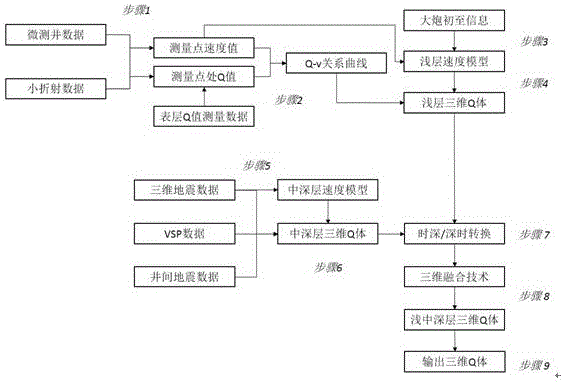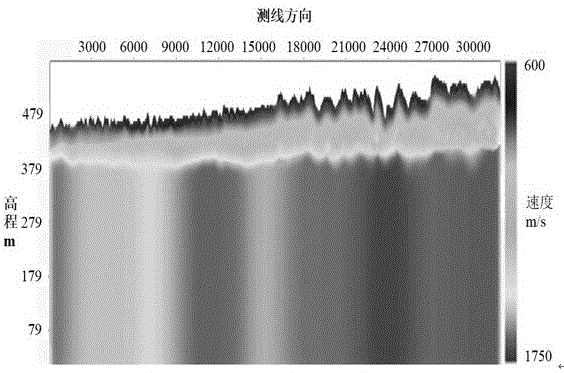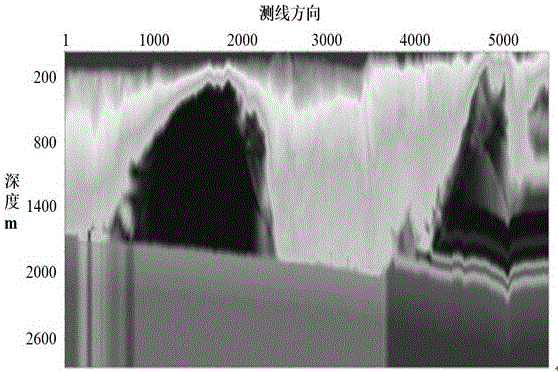Establishing method for three-dimensional Q body of shallow, medium and deep layers based on multi-information joint constraint
A construction method and multi-information technology, which is applied in the field of shallow, middle and deep 3D Q-body construction constrained by multi-information joint constraints, can solve problems such as low precision, lack of multi-type information constraints, poor stability, etc.
- Summary
- Abstract
- Description
- Claims
- Application Information
AI Technical Summary
Problems solved by technology
Method used
Image
Examples
Embodiment 1
[0030] Example 1. A shallow-middle-depth three-dimensional Q-body establishment method constrained by multiple information joints, the method comprising:
[0031] (1) Use low-level logging data such as micro-logging and small refraction to obtain the velocity value and Q value of the low-speed zone at the position of the measurement point, and constrain it through the actual measurement data of the surface Q value, so as to obtain accurate and reliable measurement points For the Q value at the position, the shallow layer mainly refers to the near-surface strata above the high-speed top interface, usually 500-1000m above the strata. Due to the reason of the 3D seismic observation system, the seismic data cannot effectively obtain the seismic information near the surface. The surface strata mainly have the characteristics of loose structure, low velocity value, and rapid vertical and horizontal change of velocity value; on the basis of obtaining the velocity value and Q value at...
Embodiment 2
[0039] Example 2. A shallow-middle-depth three-dimensional Q-body establishment method constrained by multiple information joints, the method comprising:
[0040] (1) Collect single-well micro-logging data, double-well micro-logging data, small refraction data, surface Q value measurement data, lithology coring data, lithology detection data, 3D seismic data, VSP seismic data and cross-well seismic data Data and other types of data provide basic data and constraint information for the subsequent establishment of 3D Q volumes. The more types of data collected, the better the accuracy of the method is. The shallow, middle and deep 3D Q volumes established by multi-information joint constraints are more accurate and reliable.
[0041] (2) Using low-level logging data such as single-well micro-logging, double-well micro-logging, small refraction, lithology coring, lithology detection, etc., to obtain the velocity value of the low-speed zone at the position of the measurement point...
Embodiment 3
[0049] Example 3. Such as figure 1 as shown, figure 1 It is a flow chart of the method for building a shallow-middle-depth three-dimensional Q-body constrained by multi-information joint constraints of the present invention.
[0050] In step 1, first import the low-level data such as single-well micro-logging, double-well micro-logging, small refraction data, etc., and obtain the low-speed-down zone velocity value at the position of the measurement point, the low-speed-down zone In the two-dimensional high-precision time-frequency domain of the low-measurement data, under the dual constraints of the two-dimensional signal-to-noise ratio spectrum and the two-dimensional purity spectrum, the Q at the position of the measurement point is obtained by calculating the two-dimensional time-spectrum difference value.
[0051] In step 2, with the measured data of the surface Q value as the constraint condition, the Q value at the position of the measurement point calculated in step ...
PUM
 Login to View More
Login to View More Abstract
Description
Claims
Application Information
 Login to View More
Login to View More - R&D
- Intellectual Property
- Life Sciences
- Materials
- Tech Scout
- Unparalleled Data Quality
- Higher Quality Content
- 60% Fewer Hallucinations
Browse by: Latest US Patents, China's latest patents, Technical Efficacy Thesaurus, Application Domain, Technology Topic, Popular Technical Reports.
© 2025 PatSnap. All rights reserved.Legal|Privacy policy|Modern Slavery Act Transparency Statement|Sitemap|About US| Contact US: help@patsnap.com



